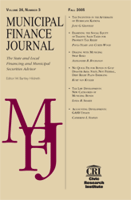U.S.Airports: Navigating a Changing Operating Environment
Author: Karen Szerszen.; Phil Hill.; Lynn Hampton.; Daniel Champeau.
Source: Volume 25, Number 02, Summer 2005 , pp.29-46(18)

< previous article |next article > |return to table of contents
Abstract:
Demand for domestic air travel peaked during the summer of 2000, with record volume taxing the U.S. air system’s infrastructure and producing extensive delays. The outcry for increased capacity was short-lived, however, as an economic downturn and the events of September 11, 2001, resulted in a drastic drop in the volume of air travel. The focus for U.S. airports changed overnight from addressing capacity constraints to survival—with management facing reduced revenues and increased security costs, and airlines in, or close to, bankruptcy. With traffic volume now rebounding and delays mounting, the industry’s capital needs are again coming to the forefront.The U.S. airline industry remains financially weak, however, and has little financial flexibility to absorb the additional costs associated with the needed capacity expansion. This article discusses recent events in the aviation industry, their impact on airport-airline relations, and the ways in which to address the system’s infrastructure needs. These articles are based on the authors’ presentations in the panel on U.S. Airports: Navigating a Changing Operating Environment at the Twenty- First Annual Conference of the National Federation of Municipal Analysts on Kiawah Island, South Carolina, May 5–7, 2004.Keywords:
Affiliations:
1: Allstate Investments; 2: Leigh Fisher Associates; 3: Metropolitan Washington Airports Authority; 4: Fitch Ratings.